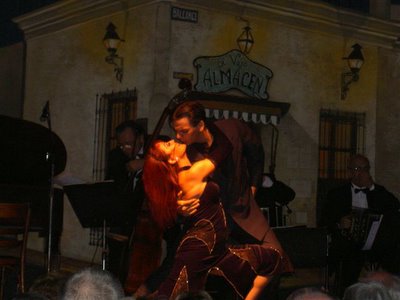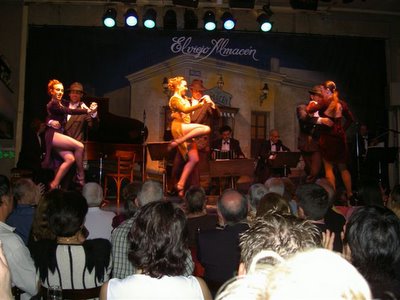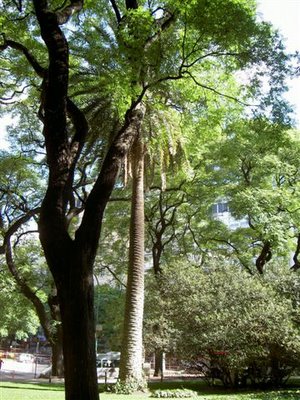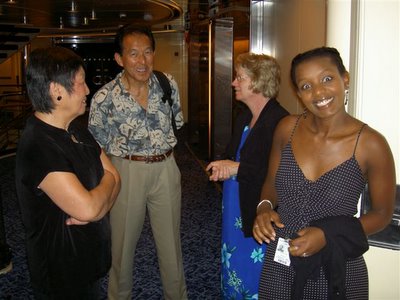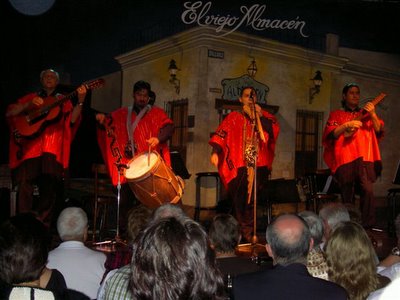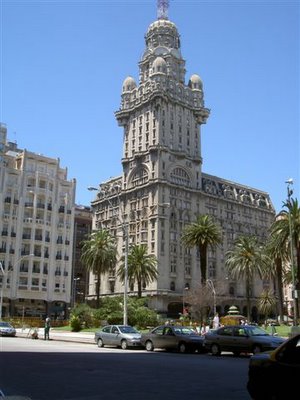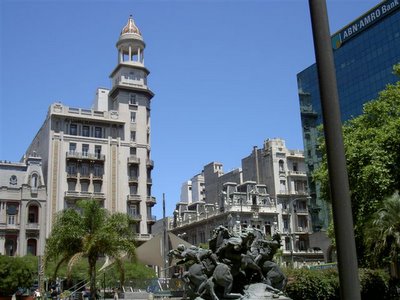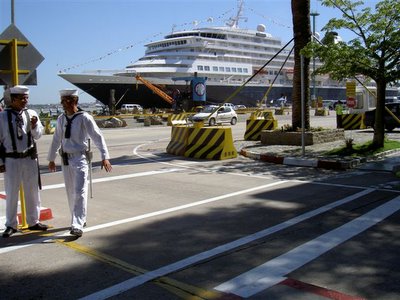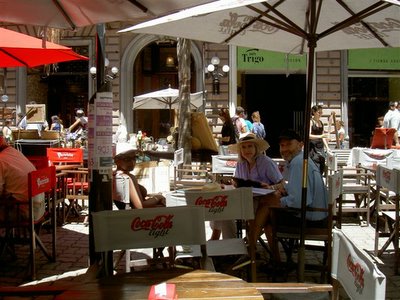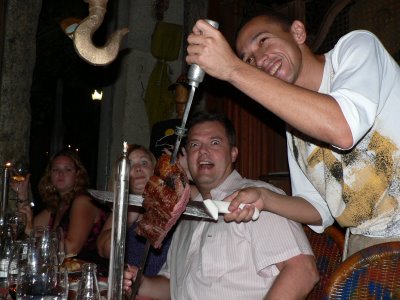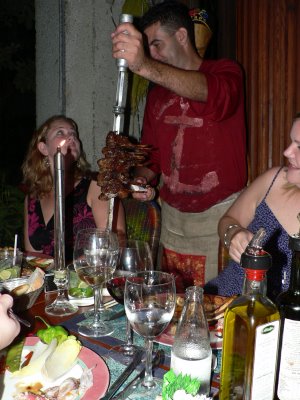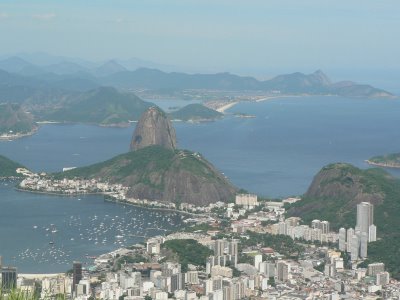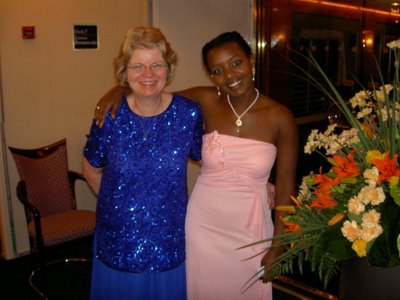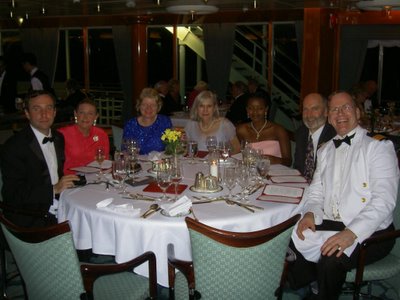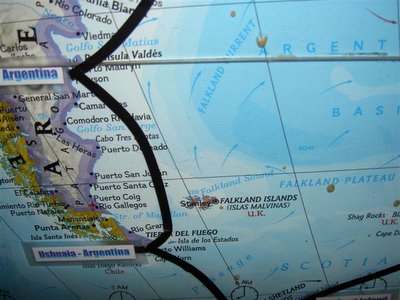
January 31, 2006
Welcome to Puerto Madryn, Argentina
Puerto Madryn is a town in Chubut Province, Patagonia, Argentina. The town was founded on July 28, 1865. 150 Welsh settlers of the ship The Mimosa named the natural port Puerto Madryn after Sir Love Jones Parry, whose title was Madryn Baron. The settlement grew as a result of the railway track laid between Madryn and Trelew built by Welsh, Spanish, and Italian immigrants. Puerto Madryn is protected by the Golfo Nuevo, which is formed by Peninsula Valdos and Punta Ninfas. It is an important town for visiting the natural attractions of the Peninsula Valdos and coast. Occupying the southern part of Argentina is Patagonia, a vast, bleak, and windswept dissected plateau. Several large rivers flow in deep valleys eastward across Patagonia to the sea. Sheep raising (chiefly for wool) and oil and natural gas production (the area around Comodoro Rivadavia is the chief oil-producing region of Argentina) are the principal economic activities of Patagonia. The poor soils of Patagonia and its cool and dry climate do not favor cultivation, although irrigated agriculture is practiced in the Negro and Colorado river valleys. Patagonia is sparsely populated and largely undeveloped, with a few small river-mouth ports on the Atlantic coast such as Viedma, Rawson, Puerto Deseado, and Rio Gallegos.
The People of Argentina
Argentina, unlike most Latin American nations, has a population that is principally of European descent, especially of Italian and Spanish origin. The mestizo portion of Argentina’s population is very small, except in the northwest, because there has been little mixture between European and indigenous peoples. The native population, which has steadily declined since the coming of the Europeans, is still strong only in parts of the Gran Chaco and the Andean highlands. Italian, Spanish, French, German, British, Swiss and East European immigrants came to Argentina during the 1880s; other large immigrations of Europeans occurred in the 1930s and following World War II. The gaucho, or Argentine cowboy, the nomadic herder of the Pampas is still a legendary national symbol. Many gauchos were people of mixed Spanish and African descent who had crossed the border from Brazil to escape slavery. By the 1990s, however, Argentina had a predominantly urban population with about four-fifths of its people living in cities and towns; more than a third of the total population lives in and around Buenos Aires. About 90% of the population is at least nominally Roman Catholic. The Jewish population, while only accounting for about 2% of the people, is the largest in Latin America and the fifth largest in the world. Argentina has one of South America’s lowest population growth rates at only 1.1% but it does have one of its highest literacy rates at 96%.
January 30, 2006
Explorations Speaker John Splettstoesser
John Splettstoesser is a geologist with extensive experience in the polar regions, particularly in Antarctica. He is a graduate of the University of Minnesota (Bachelors in Geological Engineering), and took graduate studies at the University of Nebraska. He spent eight summers conducting fieldwork in Antarctica, and has been a part-time lecturer on more than 100 cruises on tour ships to Antarctica for more than 20 years. He is an Advisor to the International Association of Antarctica Tour Operators, attending Antarctic Treaty meetings on their behalf, and has also testified on Antarctic legislation in the U.S. House and Senate in Washington, D.C. He has authored more than 175 publications in his field, including five books (edited), and received two polar medals (U.S. and U.S.S.R.) for his work in Antarctica, where he has a glacier and a mountain named for him. He is currently President of the American Polar Society (2003-2006). The first of John Splettstoesser’s lectures will be today in the Queen’s Lounge at 10:45 am entitled Antarctica as a Destination. Be sure not to miss all the exciting lectures he has to offer as well as the other Antarctic based informational sessions that will take place as we visit this isolated and grandiose continent.
January 29, 2006
Early Argentinian History
Little is known of the earliest inhabitants of the region. Only in northwest Argentina was there a native population with a material culture. They were an agricultural people (recalled today by ruins north of Jujuy), but their importance was eclipsed later by the Araucanians from Chile. Europeans probably first arrived in the region in 1502 in the voyage of Amerigo Vespucci. The southern inhabitants at that time primarily hunted and fished, while the northwestern Incas were agricultural and quite advanced, having built a highway before the arrival of the Spanish. The search for a southwest passage to Asia and the East Indies brought Juan Diaz de Solis to the Rio de la Plata in 1516. In 1520 Ferdinand Magellan entered the estuary, and Sebastian Cabot ascended the Parani and Paraguay rivers in 1536. Pedro de Mendoza in 1536 founded the first settlement of the present Buenos Aires, but native attacks forced abandonment of the settlement, and Asuncion became the unquestioned leading city of the Rio de la Plata region. Buenos Aires was refounded in 1580 by Juan de Garay. His son-in-law, Hernando Arias de Saavedra, secured the division of the Rio de la Plata territories, and Buenos Aires achieved a sort of semi-independence under the viceroyalty of Peru in 1617. The mercantilist system, however, severely hampered the commerce of Buenos Aires, and smuggling, especially with Portuguese traders in Brazil, became an accepted profession. While the cities of present west and northwest Argentina grew by supplying the mining towns of the Andes, Buenos Aires was threatened by Portuguese competition. By the 18th century, cattle (which were introduced to the Pampas in the 1550s) roamed wild throughout the Pampas in large herds and were hunted by gauchos for their skins and fat. In 1776 the Spanish government made Buenos Aires a free port and the capital of a viceroyalty that included present Argentina, Uruguay, Paraguay, and (briefly) Bolivia. From this combination grew the idea of a Greater Argentina to include all the Rio de la Plata countries, a dream that was to haunt many Argentine politicians after independence was won.
January 28, 2006
Buenos Aires, Argentina
The other passengers are fascinating. We met one woman who was on the original Prinsendam 90 some years ago when it sank. I thought it was rather bad luck to name a ship after one that sank, but I guess it doesn’t bother Holland America. Anyway, this lady is amazing and had already booked for the World Cruise next year.
A few impressions of Buenos Aires: The streets are impressively wide. When you get stopped by a stop light, it is a long wait. No human being could walk across the 10 lanes of traffic in down town during a normal light. There are railway tracks across most of the roads and they are excellent speed bumps. SOOO uneven.
There are lovers making out in every park at any hour. Carter’s camera was clicking.
The shoppers are dressed smartly. Carter was approached by every hawker in sight. He was dressed in his safari outfit, with each inch of skin covered, along with his hat and wondered if he indeed looked like a tourist…..I would say “yes”.
The lead nurse had her purse stolen in Rio by someone riding by on a bicycle. She sustained a significant rope burn to her wrist. She and her friend reported the lost credit card to a hotel immediately. She was notified that within 30 minutes there had been an attempt of $3,600 worth of charges. Buenos Aires feels much safer, on the whole, but we don’t take chances.
We are on the same river that Magellan thought was the Southwest Passage. Rather awesome. The river here is the same muddy color as the Amazon, but moving much slower.
Winnie
Jan 28, 2006
We have been in Buenos Aires, Argentina for two days and it has been great. Yesterday I went with one of the crew workers to a shopping place but we didn’t buy anything. We did see something there that the guy I went with likes to go to which is MacDonald’s. I can’t believe there is a MacDonald’s here also. I only got a really small fries and he got a hamburger. The crew who work on the ship like to go eat in MacDonald’s because they don’t get that kind of food a lot. Anyway it was fun going out with him to the shopping place. Today I went out with mom to go to the town center which is called Florida Street; it’s a shopping area for clothes and a lot of leather, and other things that is made with leather. I ended up buying a dress and sandals which look very nice and fit well. It has been fun here in Buenos Aires and we are leaving tonight at 8 p.m. I think. One more thing, when we got of the ship and we were trying to figure out where to go and which taxi to go on these girls would come up to me and the guy I was with to hand out these cards that had girls who work in strip clubs on it. He said no which was good and than she tells me if I want to come also and than she tries to hand me her card it was really weird.
We also went to a tango show last night. It was incredible, the dancers were amazing. The theater was very small and closes together so you could see the stage better and the dancers. I had never seen a tango dance like that before. I am glad that I got to experience it.
Always, Alemitu
Jan 28, 2006
Carter is weighing in at 210 # and looks like a beached whale….Having a little difficulty turning away the fantastic food and desserts and fresh bread! Work outs are a challenge with the split work schedule, second sitting where dinner ends at 10:15 pm. social obligations, dressing up continually for introductions, and cocktail parties. He has switched around day and night successfully but having a difficult time getting up at 0500 like at home. I think the key will be eating at crew mess at 1815 and getting to bed earlier when possible. Bought some fancy leather formal white shoes and black shoes yesterday in Buenos Aries which drove Winnie crazy I think. So far no guests have required emergency disembarkation, and I am getting known on a first name basis with the “regulars.” The continuity of care aspect has been fun for me….maybe I should have been an Internist after all. Leaving port right now…need to get this off. All my love!
Carter
January 28, 2006
History of Buenos Aires
The city was first founded in 1536 by a Spanish gold-seeking expedition under Pedro de Mendoza; however, attacks by indigenous peoples forced the settlers in 1539 to move to Asunción (now the capital of Paraguay), and in 1541 the old site was burned. Juan de Garay, who set out from Asunción, began a second and permanent settlement in 1580. Although Spain long neglected Buenos Aires in favor of the riches of Mexico and Peru, the settlement’s growth was enhanced by the development of trade, much of it contraband. In 1617 the province of Buenos Aires was separated from the administration of Asunción and was given its own governor; a bishopric was established there in 1620. During the 17th century the city ceased to be in danger by indigenous peoples, but French, Portuguese, and Danish raids were frequent.
Buenos Aires remained subordinate to the Spanish viceroy in Peru until 1776, when it became the capital of a newly created viceroyalty of the Rio de la Plata, including much of present-day Argentina, Uruguay, Paraguay, and Bolivia. Prosperity increased with the gradual removal of restrictions on trade, which formerly had to pass through Lima, Peru. The creation of an open port at Buenos Aires by Charles III of Spain, however, only made the citizens more desirous of separation from the Spanish Empire. In 1806, when Spain was allied with France during the Napoleonic Wars, British troops invaded Buenos Aires; their expulsion by the colonial militia without Spanish help further stimulated the drive for independence from Spain. Another British attack was repelled the following year. On May 25, 1810 (now celebrated as a national holiday), armed citizens of the cabildo (town council) successfully demanded the resignation of the Spanish viceroy and established a provisional representative government. This action inaugurated the Latin American revolt against Spanish rule. Argentina’s official independence on July 9, 1816 was followed by a long conflict between the Unitarians, strongest in Buenos Aires province, who advocated a centralized government dominated by the city of Buenos Aires, and the federalists, mostly from the interior provinces, who supported provincial autonomy and equality. In 1853 the city and province of Buenos Aires refused to participate in a constituent congress and seceded from Argentina. National political unity was finally achieved when B. Mitre became Argentina’s president in 1862.
The name Argentina is derived from the Latin argentums, meaning silver and goes back to the first voyages made by the Spanish conquerors to the Rio de la Plata. The survivors of the shipwrecked expedition mounted by Juan Diaz de Solis found indigenous people in the region who gave them silver objects as gifts. The news about the legendary Sierra del Plata (a mountain rich in silver) reached Spain around 1524. Since then, the Spaniards call the river of Solis, Rio de la Plata (River of the Silver).
1-27-06
We had a wonderful day in Montevideo, Uruguay. We took a taxi with Freddy and Steve to the Plaza of Independence. There we saw these incredible buildings and markets. We also saw this huge and really cool architectural opera building with these enormous shiny chandeliers. We also went through a pedestrian street where they had all these markets where you could buy hand made jewelry or other things like art work or antiques. While walking through the pedestrian street we got to see these interesting looking statues the people of Montevideo had built of people and bulls and other things. We also sat down and had coca’ cola in the market it was so good to drink coke out of glass bottle. Guess what I saw that is in North America everywhere? MacDonald’s!!!!!! What is MacDonald’s doing in a place this far? I thought it was very weird to see it here.
Well talk to you all later Always,
Alemitu
From Winnie:
In Montevideo Carter and I had one of those frustrating experiences – based solely on not knowing the language. There was a “free” shuttle from the ship to the main Plazas. Of course, there was an ulterior motive. Once on the shuttle, they drove us around and dropped us off in a suspect location to “visit” one of their leather shops. Since we didn’t know where we were and couldn’t speak the language, we needed to wait until they picked us up. Carter did buy a belt. We kept asking “Plaza? Plaza?” and the driver assured us that we were going to the Plaza. Well, the next stop was a gift shop specializing in sweaters. We must have waited for about 30 minutes for the next shuttle bus and then the same conversation ensued, “Plaza?” and we were assured we were going to the Plaza. Well, the next stop was back on the ship. Crazy! We figured the taxi was the way to go when we tried again in the afternoon.
Winnie
January 27, 2006
Welcome to Buenos Aires, Argentina
Buenos Aires, the capital of Argentina, is located on the Rio de la Plata. In its center are the Plaza de Mayo, a square whose buildings include the Casa Rosada (pink house), the office of the Argentine president, and the cabildo, the former meeting place of the colonial town council and now a national museum. The Avenida de Mayo extends from the square to the Palace of the National Congress. Other famous streets are the Avenida 9 de Julio (commemorating the date of Argentina's independence from Spain, July 9, 1816), said to be the world's widest boulevard; Calle Florida, the main shopping thoroughfare; and the Avenida de Corrientes, which is the nucleus of the theater and nightclub district, often called the Broadway of Argentina.
Buenos Aires also has many beautiful parks, including Palmero Park. The cathedral (completed 1804) is a well-known landmark containing the tomb of Jose de San Martan. Among the numerous educational, scientific, and cultural institutions are the University of Buenos Aires and several private universities; the National Library; the Teatro Colan, one of the world's most famous opera houses; and the Museum of Latin American Art. La Prensa and La Nacian are daily newspapers famous throughout the Spanish-speaking world. The city has a subway system and is a railroad hub as well as a center of inland seaborne traffic.
Language in Buenos Aires
In the early 20th century, Argentina absorbed millions of immigrants, mostly from Italy and Spain. Italian immigrants spoke mostly local dialects (mainly Nnapulitano, Sicilianu and Genoese), and their adoption of Spanish was gradual. The pidgin of Italian dialects and Spanish was called cocoliche. It was used roughly until the 1950s, and today survives mostly as comic relief. The lunfardo argot originated within the prison population, and spread to all with time. Lunfardo uses words from Italian dialects, and tricks such as inverting the syllables within a word. Lunfardo is used mostly in informal settings. Yiddish was common in Buenos Aires, especially in the Balvanera garment district, until the 1960s. A lively Korean language and Chinese language press has developed since the 1980s, but younger immigrants assimilate into Spanish quickly. The dialect of Spanish spoken in Buenos Aires (as well as in other large cities like Rosario and Montevideo, Uruguay) is characterized by voseo, yeasmo and aspiration or loss of syllable-final -s. Due to its geographical location it receives the name of Rioplatense Spanish.
Buenos Aires Economy
One of the largest cities of Latin America, Buenos Aires is Argentina’s chief port and its financial, industrial, commercial, and social center. Located on the eastern edge of the Pampa, Argentina’s most productive agricultural region, and linked with Uruguay, Paraguay, and Brazil by a great inland river system, the city is the distribution hub and trade outlet for a vast area. The historical importance of its port, one of the world’s busiest, has led the citizens of Buenos Aires to call themselves “people of the port”. Meat and dairy products, hides, wool, flax, and linseed oil are the chief exports. Buenos Aires, the most heavily industrialized city of Argentina, is a major food-processing center, with huge meatpacking and refrigeration plants and flourmills. Other leading industries are metalworking, automobile manufacturing, oil refining, printing and publishing, machine building, and the production of textiles, chemicals, paper, clothing, beverages, and tobacco products. Factories began to move into some of the suburbs in the 1980s.
The Tango
Many immigrants arrived in Buenos Aires without their families, which led to a significant phenomenon of prostitution starting around 1870. The erotically charged tango dance originated in brothels, but later found a wider audience. In 1902, the Teatro Opera started organizing tango balls. In the 1920s, tango was adopted by the Parisian high society and then all over the world. The Buenos Aires style of tango music evolved into an elaborated genre.
January 26,2006
Welcome to Montevideo, Uruguay
Montevideo is the capital and largest city of Uruguay, situated in the south of the country at the northern mouth of the very wide Plata River across from Buenos Aires at the southern side. It is one of the major ports of South America and the governmental, financial, and commercial center of Uruguay. Much of the South Atlantic fishing fleet is based in Montevideo. The Portuguese founded Colonia del Sacramento in the 17th century despite Spanish claims to the area due to the Treaty of Tordesillas. The Spanish chased the Portuguese out of a fort in the area in 1724. Then, Bruno Mauricio de Zabala - governor of Buenos Aires - founded the city on December 24, 1726 to prevent further incursions. In 1828, the town became the capital of Uruguay. There are at least two explanations for the name Montevideo: The first states that it comes from the Portuguese “Monte vide eu” which means, “I see a mountain”. The second is that the Spaniards recorded the location of a fountain in a map as “Monte VI De Este a Oeste” meaning “The sixth mountain from east to west”. The city's full original name is San Felipe y Santiago de Montevideo. The city fell under heavy British influence from the early 19th century until the early 20th century as a way to circumvent Argentine and Brazilian commercial control. Argentinean dictator Juan Manuel de Rosas between 1838 and 1851 repeatedly besieged it. montevideo continued
Between 1860 and 1911, the British built an extensive railroad network linking the city to the surrounding countryside. During World War II, a famous incident involving the German pocket battleship Admiral Graf Spee took place in Montevideo, which was a neutral port during the war. After the Battle of the River Plata with the British navy on December 13, 1939, the Graf Spee retreated to the port. To avoid risking the crew in what he thought would be a losing battle, Captain Hans Langsdorff scuttled the ship on December 17, 1939.Montevideo began as a minor settlement. In 1860, Montevideo had a population of 37,787. By 1884, the population had grown to 104,472, including many immigrants. By this time, trade had become the main source of revenue for the city and it became a rival to Buenos Aires. During the early 20th century, many Europeans immigrated to the city, and by 1908, 30% of the population was foreign born. During the mid-20th century, military dictatorship and economic stagnation caused a decline whose residual effects are still seen today. Many rural poor flooded the city, with a large concentration in Ciudad Vieja. Recently, economic recovery and stronger trade ties with Uruguay’s neighbors have led to renewed agricultural development and hopes for greater future prosperity. As of 2004, the city has a population of 1.35 million out of a total 3.43 million in Uruguay. The greater metropolitan area has 1.8 million people.
January 25, 2006
At Sea out of Montevideo, Uruguay
Suddenly it is cooler, thank goodness. Alemitu is cold and threatening to wear her P-coat to dinner.
Carter is thrilled because Steve asked to see his blow gun and wasn’t joshin’. I wonder if it is considered a weapon by security.
The internet is down and went down right in the middle of my answering my mail. I know that Lisa wrote something about a bill, but it is lost for the time being. I am sure this will happen more and more as we get further south. Frustrating.
I haven’t missed a day in the gym yet. People think I am a fitness freak. Little do they know….. I just want to eat that extra chocolate before I go to bed.
Winnie
Januaary 24, 2006
Explorations Speaker Terry Hughes
Terry Hughes was Head of BBC TV Variety during what has been described as the ‘golden years’. In this capacity he oversaw production of such shows as “Morecame & Wise”, “The Two Ronnies”, “Mike Yarwood”, “The Generation Game” and “Dick Emery”. As Producer and Director of “The Two Ronnies” he received seven British Academy Film & Television Award Nominations and one win. He also produced and directed shows with Barry Humphries; he is especially proud of the acclaimed “Ripping Yarns” written by and starring Michael Palin. In 1980 Mr. Hughes and his family moved to Los Angeles where he soon became one of the premier producers and directors of hit situation comedies. These include “The Golden Girls” (for which he received six Emmy nominations and two golden statues). He went on to direct John Lithgow in “3rd Rock from the Sun” (receiving another Emmy nomination) and episodes of the long running show “Friends”. He also directed the pilot episodes of the hit shows “Blossom” and “That 70’s Show”. Mr. Hughes has also directed many musicals for TV including “Sweeney Todd” (another Emmy Award), “Sunday in the Park with George”, “Barnum” with Michael Crawford and “Mrs. Santa Claus” starring Angela Lansbury. He also directed the feature films “The Butcher’s Wife” starring Demi Moore and “Monty Python Live at the Hollywood Bowl”. For the stage he directed “The Two Ronnies” at the London Palladium.
January 23, 2006
1-23-05
Yesterday we were still in Rio de Janeiro, Brazil. We got off the ship to look for a market so I could buy a hat for the sunny weather here. But we got lost and we didn’t know where it was and mom and dad were arguing about the directions and I am just telling them to go back to where the ship is and ask for directions and also gets some money because dad got off the ship without his wallet. While we were lost, there were these two little girls that run up to mom and dad and started begging them for money. The two little girls fallowed us everywhere. They started calling mom and dad Mommy, Daddy and they started holding dads hand while walking. That experience was very interesting, sad and funny at the same time. The part that was very interesting for me was that the two little girls that were begging were only doing it to mom and dad but never once to me, I thought that was odd. We finally did end up going back to where the ship was and dad went back on the ship and got his wallet while mom and I stayed behind and asked the people in charge question on where to go. There was a guy that helped us and we ended up going on a car to H. Stern’s Jewelry. There we got a tour on how the Jewelries are made. While I was there I bought a hat for myself for 9 dollars it was a bit expensive but I needed it for the sunny days. Anyway we are same and for the next two days we are at sea to reach Montevideo, Uruguay.
Until next time always,
Alemitu.
Just a quick note from Winnie. Steve and Freddie Rice joined the ship yesterday and are with us until South Africa. It is SO nice to see someone from home, on top of being fun for us to see someone experience ship life for the first time. Each little event that we have taken as routine is an new adventure for them……We have a knitting group on board. We are knitting for an orphanage in Africa, so the ship provides the yarn and we do the work. I get so much done during each lecture – plus I listen to the lecture even more carefully.
Winnie
January 23, 2006
Eva Perón
Eva Perón, one of the most famous Argentine political figures, was born María Eva Duarte in Los Toldos, Argentina in 1919. She began an acting career when she was 15 and continued to act until she met her husband. Her career flourished as a successful radio soap opera actor and in 1944 she met Juan Domingo Perón, whom she married one year later. Juan was elected president of Argentina in 1946. After his inauguration as president, Eva Perón became a favorite of her country’s citizens and an influential, although unofficial, member of Perón’s government. She played an active role in politics, became his liaison with labor, created the Eva Perón Foundation (a social welfare institution), and organized the women's branch of the Justicialist Party. Her own experiences with poverty and the working class enabled her to act capably as her husband’s political liaison with labor interests, women, and the poor. As a result of her social-welfare work with Argentina’s disadvantaged, she was affectionately known as Evita. By 1949, Evita was the second most influential figure in Argentina and co-leader of the descamisados (shirtless ones), the mainstay of her husband's support. Worshiped by her followers and hated by her opponents, she sought the vice-presidency in 1951 but was blocked by the military. After our visit to Uruguay, we will be in Buenos Aires, Argentina where you can visit the Recoleta, the mausoleum of Eva Perón.
January 22, 2006
Scenic Sail Away from Rio de Janeiro on Mon am 0800 Jan 23rd.
The city is also famous for its beautiful beaches, such as Copacabana and Ipanema; but it is the harbor that draws tourists from around the world. Rio has one of the world’s most beautiful natural harbors and was declared one of the Seven Wonders of the Natural World by CNN. Among its natural landmarks are Sugar Loaf Mountain at 1,296 feet, 395 meters and Corcovado Mountain at 2,310 feet, 704 meters, is the site of a colossal statue of Jesus known as Christ the Redeemer, “Cristo Redentor”.
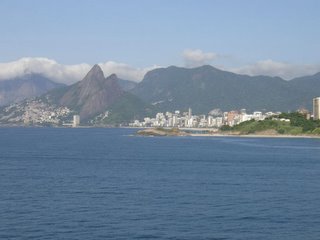
January 21, 2006
We have arrived in Rio and are awaiting the arrival of Steve and Freddie Rice. It is a beautiful harbor…almost as picturesque as Vancouver, BC. We have a crew only open-Jeep tour to Tijuca Forest this afternoon from 1300-1700 which is the world’s largest urban forest, reportedly with a beautiful waterfall, tropical animals, monkeys, sloths, and exotic birds. Will let you know more after the trip. Am getting to know a number of patients on a first name basis…I do enjoy the continuity of shipboard primary care and so far, no one has required disembarkation. Problems are mostly urgent care with a fair amount of surveillance paper work necessary to satisfy the local authorities in each port. Cindy, Lito, and Micheline have been very patient with my tutelage. How are things back in the USA?? All our love!
Carter
Today we reached Rio de Janeiro. Once we were off the ship we went to catch a jeep that was going to take us on a tour of the rainforest. The rainforest was so beautiful everything was green; all the different kinds of trees were amazing to look at. We also saw a huge waterfall that was coming down the mountain. I took some picture of the waterfall. We also saw a group of raccoon near the garbage can and I took some pictures of them. The raccoons were coming up to me and others thinking we had food. It was cool to see them up so close. The people seem to be very nice here also. While we were coming down from the mountain we saw bunch of beaches full of people, never seen beaches so full of people as these ones. By far from all the places I have see on this trip this place is the most beautiful and exciting city that I would want to come back to.
Until next time always,
Alemitu
____________________________________________________________________________________________
January 21, 2006
Rio de Janeiro, Brazil
Rio de Janeiro is the capital of Rio de Janeiro state, in southeast Brazil, on Guanabara Bay of the Atlantic Ocean. It is the second largest city and former capital of Brazil, as well as the cultural center of the country and a financial, commercial, communications, and transportation hub. It has an international airport and a subway. The area where Rio de Janeiro is now was reached by Portuguese explorers in an expedition led by Italian Amerigo Vespucci in January of 1501. Since the Europeans thought at first the Bay of Guanabara was actually the mouth of a river, they called it “Rio de Janeiro”, which means January River. In 1555 the French Huguenots established a colony, but the Governor General of the Portuguese colony of Brazil drove them out between 1560 and 1565. The city was not founded until March 1st, 1565 by Portuguese knight Estácio de Sá, who called it São Sebastiao do Rio de Janeiro (San Sebastian of the January River), in honor of then King Sebastian I of Portugal. For centuries, the settlement was commonly called São Sebastião, even St. Sebastian, instead of the currently popular, second half of its name. Pirates and privateers, especially by then enemies of Portugal, such as the Netherlands and France, frequently attacked it. In the late 16th century, the Portuguese crown began treating the village as strategic location for Atlantic transit of ships between Brazil, the African colonies and Europe. Fortresses were built and an alliance was formed with nearby native tribes to defend the settlement against invaders. The exact place of Rio’s foundation is at the feet of now world famous Sugar Loaf Mountain. Later, the whole city was moved on top of a hill, imitating the medieval European strategy of defense of fortified castles; the place was since then called Morro do Castelo (Castle Hill). Until early 18th century, the city was threatened and invaded by several pirates and buccaneers, such as Jean-Francois Duclerc, René Duguay-Trouin, and Nicolas de Villegaignon. The settlement was actually captured and held for ransom by the French in 1711.After 1720, when the Portuguese found gold and diamonds in the neighbor captaincy of Minas Gerais, Rio de Janeiro became much more useful port to transport out the wealth than farther Salvador. In 1763, the colonial administration in Portuguese America was moved to Rio. The city remained mostly a colonial capital until 1808, when the Portuguese Royal Family and most of the Lisbon nobles, fleeing from Napoleon’s invasion of Portugal, moved in. The kingdom’s capital was transferred to Rio, which then became the only European capital outside of Europe. Since there was no physical space or urban structure to accommodate hundreds of noblemen who arrived suddenly, many inhabitants were simply evicted from their homes. modern day history
When Prince Pedro proclaimed the independence of Brazil in 1822, he decided to keep Rio de Janeiro as the capital of his new empire, yet the city region was losing economic and political importance to São Paulo. Rio was maintained as the Brazilian capital after the military overthrew the monarchy and imposed a republic in 1889; however, plans for moving the nation’s seat city to the territorial center were considered, until president Juscelino Kubitschek was elected in 1955 and took office in 1956 with a promise to build a new capital. Though many thought it was campaign rhetoric, Kubitschek managed to have Brasi¬lia built by 1960, at great cost. On April 21st, 1960, the capital of Brazil was officially moved from Rio to Brasi¬lia.
city districts
The city is commonly divided into the historic downtown (Centro); the tourist-friendly South Zone, with world-famous beaches; the industrial North Zone; and the West Zone, home to the newer Barra da Tijuca region.
centro
Centro is the historic downtown of the city. Sites of interest include both the historic Church of the Candelaria and the modern-style cathedral, the Municipal Theater, and several museums. Centro remains the heart of the city’s business community.
south zone
South Zone is famous for its scenery: Copacabana beach boasts one of the world’s most spectacular New Year’s Eve parties; Sugar Loaf Mountain, whose name characterizes the famous hump rising out of the sea; Corcovado Mountain, with an incredible view of the city; and Topsail Rock, the tallest mountain in the city at 842 meters.
January 20, 2006
We have another sea day, so a little time to reflect. I tried to get Alemitu to write, but she has been laid low with seasickness again. Poor kid.
Alemitu and I were waiting for Carter to finish with clinic so we could go into Recife on the 18th. Then we found out that Alemitu had to do a special crew clinic on Antarctica. Carter and I had done it the day before, but I agreed to sit thru it with her since she didn’t want to be alone. It was rather on the boring side, but she survived. Then just as we were going to leave the ship Carter got called about an injury so we took off on our own.
We took a shuttle bus into the town and were dropped off in a relatively unsavory place. There were no street signs, just general directions from crew who were returning from the shopping center, so we headed off on foot, trying to memorize the buildings and landmarks so we could find our way back to the bus stop. The sidewalks were so interesting because they all were made the white and black stones in a mosaic design. Some of them were in disrepair with huge holes of sand, but they were easily jumped. As we walked we kept remarking that the buildings looked European, almost like St. Petersburg, with similar loud colors. We walked for about 20 minutes, over several bridges, passing unbelievable traffic that paid no attention to pedestrians, and finally decided the shopping mall was going to have to go down as a missed opportunity. It was windy, thank goodness, to combat the 90 degree temperature, and for some reason the humidity was less than it had been in days.
We did manage to find our way back to the bus stop without mishap, other than multiple stares. They don’t have many people as pale as I, plus I was the only person around wearing a hat. Once at the bus area we had to wait for about 20 minutes. There were some very aggressive beggars who Alemitu felt looked healthy enough to have regular jobs. The one that horrified her the most was one who was about 8 months pregnant and smoking.
Tomorrow we land in Rio. Some passengers will be leaving the ship and others joining. Some of my gym friends are the ones leaving. I’ll miss their support.
Winnie
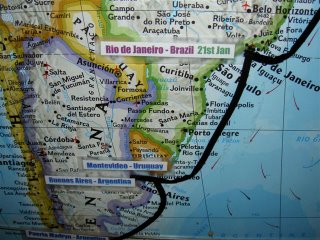
January 20, 2006
Map of Brazil
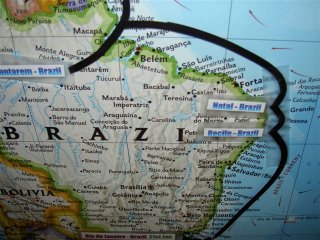
January 19, 2006
Carmen Miranda
Arguably Brazil’s most famous export, Carmen Miranda was actually born Maria do Carmo Miranda da Cunha in Portugal, February 9, 1909. Her family, barber father, seamstress mother and six children in total, moved to Rio de Janeiro when she was very young. At the age of 15, she dropped out of Catholic School and worked in a hat shop, where she began her love for creating and modeling hats for the customers and she danced and sang for them. An affluent customer requested a performance at one of their parties, which marked a turning point in the young women’s career. “Triste Jandaya” (Sad Parakeet) was her first hit song and the next year “Tia” sold over 35,000 copies. Brazil adored their La Pequena Notavel (The Remarkable Little Girl) and over the next ten years she recorded almost 300 songs ranging from tangos to Carnival marches and rhumbas, the majority being samba. By the age of 26, Carmen Miranda was a household name throughout Brazil, having acted in five Brazilian movies in addition to her glamorizing samba music and her extravagant salary. Soon after this she took on the Bahiana costume: “a silk turban with fruit and other items, golden earrings, bracelets, a silver buckle and sandals, with strings of beads around her neck, colorful skirt and bare midriff.” Her first American success was the song “O Que e Que a Bahiana Tem?” (What Does the Bahian Girl Have?) from the movie “Banana da Terra” and later performed in New York City in 1939. showtime
Kevin Devane is experienced in all types of comedy entertainment and a proven crowd pleaser, having appeared in almost every major British nightclub and theater experience, which includes numerous appearances at the London Palladium. In the past he has also performed for TV, not only for his own half hour special for SKY Television but also as a guest artiste on several networked television shows.
All of her songs at this time were sung in Portuguese yet American audiences loved and praised the fresh feel of the Queen of Samba. After returning to Rio de Janeiro a year later to perform, she was accused of coming back too Americanized and later returned singing “Disseram Que Voltei Americanisada” (They Say I Came Back Americanized), which enamored her Brazilian audience. She spent the next 14 years in the United States of America where she continued with her acting, singing and radio career – adding another title, The Brazilian Bombshell. Following a rocky marriage to her co-producer David Sebastian in 1947, “Carmen suffered depression, exhaustion, overmediacation and even electroshock therapy. She took an extended vacation to Rio de Janeiro in December 1954 and the next year, on “The Jimmy Durante Show”, she collapsed during a dance routine. The next morning, August 5, 1955, Carmen Miranda died from a heart attack; she died unexpectedly at the age of 46. Millions of fans visit the Carmen Miranda Museum and Sao Joao Batista Cemetery, both in Rio de Janeiro, ever year to see where she is buried and pay homage to her amazing legacy. 2005 marks 50 years since her death and her samba beats, fiery temperament, stunning beauty and extravagant costumes still hold a place in countless hearts.
(continued on the back)
January 18, 2006
Welcome to Recife, Brazil
Recife is the capital of Pernambuco state, northeastern Brazil. It lies on the Atlantic Ocean south of Natal and is the chief urban center of northeast Brazil and an important transportation hub. It lies partly on the mainland and partly on an island. Dissected by waterways, surrounded by rivers and crossed by bridges, Recife is full of islands and mangrove swamps that magnify its geography. It is known as the American Venice, thanks to its fluvial similarity with the European city, and is considered one of Brazil's cultural capitals. Its fine natural harbor is enclosed by a coral reef. Recife exports great quantities of the hinterland's products, including sugar, cotton, and coffee. First settled in 1535, the Portuguese officially founded it in 1548 as the port for nearby Olinda, Recife was settled by fishermen and sailors. The city was plundered by the British in 1595 and was occupied by the Dutch from 1630 to 1654, prospering under Maurice of Nassau. After the Dutch occupation, Recife replaced Olinda as capital of the Pernambuco captaincy. During World War II, an Allied air base was there. The city has three universities and several research centers and museums; it has long been famed for its intellectual groups and political ferment. In addition to its modern buildings, Recife has a 17th century cathedral, a Dutch fort, an elaborate government palace, and the ruins of what is believed to be the first synagogue in the New World, which flourished during the Dutch period.
January 18, 2006
Today we are in Recife, Brazil. It is still early morning, so we haven’t gotten off the ship yet. We have word that it is rather dangerous here for tourists, not to wear any jewelry or carry anything valuable. People often have their ear rings stolen off their ears. Don’t know how much of this is urban legend, and how much truth. We’ll be careful.
We missed our stop in Natal, Brazil because the winds were too high for our large ship to go into the shipping channel. It was a disappointment, but you have to go with the flow. We always seem to have enough to do here on board.
Carter and I went to a crew bingo night several nights ago and it was so much more active, loud and fun than the usual passenger bingo games. It was especially nice to see the crew in regular clothes, rather than their uniforms. They were relaxed and having a good time, rather than being quiet and super polite to the passengers.
Our cabin is on the small side and since we had the couch removed so Alemitu could get a bed, they had to squash the one chair into the corner between Alemitu’s bed and Carter’s side of the bed. That meant that every time Carter wanted to get out of bed, he had to climb over the chair in a very undignified manner. Well, he finally could handle it no longer and moved the chair over to my side, wedging it between my side of the bed and the desk. I found this impossible to deal with and yesterday morning asked the cabin steward to remove it. What a deal! Now we are all happy!
My bite on my arm is finally going away, thank goodness. It was funny that I was the only person I know of who got bit in the Amazon area. I shudder to imagine my magnetic strength for the mosquitoes when we arrive in Kenya or India.
Winnie
Jan 17, 2006
Welcome to Natal Brazil
A city of northeast Brazil on the Atlantic Ocean north of Recife, Natal is the capital of Rio Grande do Norte state, northeast Brazil, just above the mouth of the Potengi River. It is a modern city that has retained its colonial flavor and is beautifully situated among white palm-studded beaches. Its port is important in the handling of coastal shipping and in the export of tungsten. There is also some light industry. Natal was founded on Christmas Day, 1599. It was occupied by the Dutch from 1633 to 1654 and in 1817 was briefly the seat of a republican government until it was suppressed by imperial authorities. Because of its strategic position (Natal is one of the cities in Brazil nearest to Africa and Europe), an American military base was built in the outskirts of Natal during the World War II years; this base provided support for allied troops combating in the north of Africa. Thousands of American soldiers were sent to Natal, and their presence left traces in the culture of the city. Last century, Natal benefited from the growth of the industries of salt (the north of Rio Grande do Norte is the largest producer in Brazil) and petroleum (the largest inland Brazilian reserves are in the State). Natal grew quickly, but in a somewhat planned way; transit flows smoothly, public services are well distributed, ecologic conscience is visible; violence levels are low. Tourists (first Brazilians, more recently foreigners) discovered the city, which became one of the major tourist destinations in Brazil.
History of Brazil
In 1500 Pedro Alvares Cabral set sail from Lisbon with 13 ships and 1200 crew, ostensibly for India, and arrived on the Brazilian coast near present-day Porto Seguro by ‘accident’. Some historians say it was his intended destination all along, and it is true that his ‘discovery’ was reported to the king in such matter-of-fact terms that it seems that the existence of Brazil was already well-known to mariners. In 1531 King João III of Portugal sent the first settlers to Brazil and, in 1534, fearing the ambitions of other European countries, he divided the coast into 15 hereditary captaincies, which were given to friends of the Crown. The colonists soon discovered that the land and climate were ideal for growing sugar cane, and solved the prodigious labor requirements by enslaving the Indian population. The capture and sale of slaves soon became one of Brazil’s most lucrative trades. Their brutal exploits, more than any treaty, secured the huge interior of South America for Portuguese Brazil. From the mid-16th century, African slaves were compelled to replace Indians on the plantations. They were less vulnerable to European diseases, but their lives were short nevertheless. Quilombos, communities of runaway slaves, were common throughout the colonial era. They ranged from mocambos, small groups hidden in the forests, to the great republic of Palmares that survived for much of the 17th century. In the 1690s, gold was discovered in Minas Gerais and the rush was on.
January 16, 2006
Yesterday we crossed the Equator. As the captain blew the ship’s whistle, Alemitu jokingly looked in the water and said, “Where is the line?” Soon thereafter the judging of Poseidon, or Neptune, took place. All passengers who have never crossed the Equator are considered pollywogs and need to have their characters judged by Poseidon. If they are not worthy, they are sent over the side of the ship. On this ship, only the crew who are sent to Neptune, thank goodness. It ended up that Carter was considered a pollywog because he had never going over the Equator in a ship. We had gone over numerous times in a plane or on land. Anyway, I think they wanted a few more victims. They were marched out, had to kiss a disgusting dead Amazon fish, were judged and then were placed on a table and covered with nasty food products. There was spaghetti noodles, jello water, flour, tons of food coloring, oatmeal. They started with the wet stuff that Carter said tasted sweet, then the dry. His clothes became matted with a doughy substance. Then they were judged again by all the chief officers and were either told to walk the plank (jump in the pool), or they were saved and made to bake on the side of the pool. It was certainly better to walk the plank, but Carter and the nurse were saved and had to sit in the sun until all the other crew were finished.
Make sure you check out the website to see the photos of Carter. It was most colorful and the passengers and crew seemed to enjoy the frolic. His clothes were beyond description. Luckily, I could send them thru the laundry here on the ship and not have to even touch them!
Today has been a leisurely day cruising on our way to Natal. The sea is calm and we all feel quite lazy. There have been such interesting speakers, one talking about the native plants and animals. The fish Carter had to kiss only eats nuts! We are all getting quite an education.
Winnie
Hello everyone…..Boy am I gaining weight out here. The food is fantastic, and I am almost at the point of not going to the formal dining room every night because 1) It starts at 8:15 pm 2) It goes on for 2 hours 3) By 10:15 pm I am ready for bed and so all those calories go to my waist. 4) The folks we are eating with are very, very, very “interesting”….which means I can’t really tell you everything as this is a public forum I am writing in.
Alemitu is having some “issues” with the close environment we are living in….as in the bedroom. For some reason she is annoyed with my snoring, sleep talking, and all the ‘other’ noises that people can imagine. She doesn’t seem to get that others might become equally tired of expressions like “I have a huge zit on my back” which is repeated 5-10 times for emphasis or “you don’t understand how hard it is to take care of my hair.” I must mention she is reading all this out loud and over my shoulder as I am typing….We have NO secrets out here. All in all, we are settling into the shipboard routines and getting to know the 500 octagenarians for whom I am “Doc.” Winnie is finally beginning to rest and get a well deserved vacation. More to follow!
Carter
Hi everyone? Yes I am getting annoyed living in the same room as my dad and mom and I have only been on the ship for 2 weeks I think. Anyway I am getting little bit of zits on my face because it is very humid out here and when I am around humid areas I tend to get zits sometimes it is very annoying. On the night we had a formal night I had this zit on the back of my shoulder which was annoying because I was going to wear my beautiful green dress. In the, I ended up wearing my dress and I still looked good, I know I looked good because people were telling me I looked great. I am still having a great time here and I hope all of you are having fun too.
Always, Alemitu
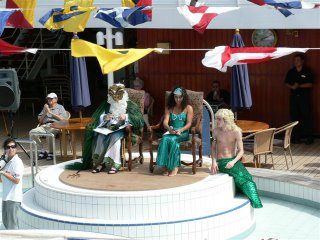
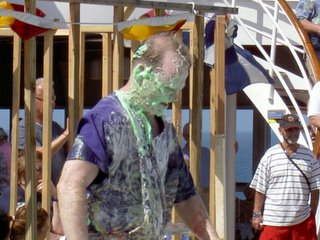
King Neptune Ceremony for a Polywog's(Carter) Crossing the Equator
Crossing the Equator
Today the Prinsendam will cross the equator, which is an imaginary reference line that encircles the earth and divides our planet into Northern and Southern hemispheres. It is the widest of the latitude lines that ring the earth. Latitude lines are one of two measurements needed to locate points precisely on the earth’s surface. Running north-south, longitude lines have their zero-point running through the Royal Greenwich Observatory in England. This “longitudinal equator” is called the prime meridian. As the center point of the earth, the equator is also the center of the tropics. The tropics is the area lying between the Tropic of Cancer and the Tropic of Capricorn, at 23°27" north and south of the equator. The climate in the tropics varies; some areas have heavy rainfall, and others are very hot and dry. The sun’s heat near the equator easily evaporates water from the oceans, so the hot tropical air is also moist. This is why there are rain forests at the equator. Also, at the equator, the sun’s rays are unaffected by the tilt of the earth, so the area is always exposed to the sun and receives direct solar rays year-round, regardless of season. We think of it as being very hot at the equator. The heat is most intense at sea level, but as you move into the mountains, it can also get very cold. In fact, you might find snow at the equator! This shows how dramatically altitude affects weather at the equator. The equator also marks a turning point for the seasons, which are reversed in the northern and southern hemispheres.
Jan 14
Concern for the Amazon River
Four centuries after the discovery of the Amazon River, the total cultivated area in its basin was less than 25 square miles, 65 square kilometers, excluding the limited and rudely cultivated areas among the mountains at its extreme headwaters. This situation changed dramatically during the 20th century. Wary of foreign exploitation of the nation’s resources, Brazilian governments in the 1940s set out to develop the interior, away from the seaboard where foreigners owned large tracts of land. The original architect of this expansion was President Vargas, the demand for rubber from the Allied Forces in World War II providing funding for the drive. A large-scale colonization program saw families relocated to the forests, encouraged by promises of cheap land. Many settlements grew along the road from Brasilia to Belem, but rainforest soil proved difficult to cultivate. Still, long-term development plans continued. Roads were cut through the forests, and in 1970, the work on Trans-Amazon highway network began and was completed within ten years, connecting all the major cities of the Brazilian Amazon interior. Cattle farming became a major impetus in deforestation, with military governments in the 1960s and 1970s heavily subsidizing the creation of large ranches. By the 1980s the rate of destruction of the rainforest was dizzying, and it is estimated that over a fifth of the total area of the rainforest has now been clearcut. The preservation of the remaining forest is becoming an ever more prominent concern.
January 14, 2006
I had such a great time in Santaren, Brazil yesterday. When we got off the ship in Santaren it smelled so bad like rotten garbage and sewage around the water. When got off the ship and got to land the Santaren people greeted us so kindly with necklaces and there was a woman that was dressed like an Amazon women and people were having there pictures taken with her. We got on the shuttle bus to go to town and once we got to town there were so many crafty things to buy. The market on the square was full of food, clothes, shoes and other things you could buy. The hand made necklaces and earrings were so pretty looking. When you were looking at there things in the market the people there weren’t making you feel like you had to buy it and making you feel uncomfortable if you didn’t buy it like they do sometimes in other countries when you are bargaining. I even took a picture of a Santaren boy holding an iguana and I even touched it. It was really cool to see the boy laughing with me when I was touching the iguana. The thing I bought from there is a little jewelry box that had a real dead butterfly in the lid that was clear and you could see the beautiful butterfly through it. In all I had a memorable time in Santaren, Brazil. One more thing the people there had really nice looking skin probably from all that sun they get there.
Always, Alemitu
This is Winnie. Can’t add anything to Alemitu’s description. It sums up Santaren. Just have a few stories about us and our fellow travelers.
We have table partners for dinner who I mentioned earlier. There is a mother from Manhattan, and her 35 year old son who is an artist. The night before we arrived in Santaren the ship put packets of insect repellent on everyone’s pillow with instructions to use it if you had night time exposure to mosquitoes. The next day the mother asked her son to not forget this packet and he announced that he had applied it over his entire body the night before, put on his pj’s, and gone to bed. He, of course, washed it off the next morning. Oh, well! His mother put it on when we went into town, only to have it dissolve her fingernail polish. Potent stuff. I don’t think I would want to sleep in it!
Then, just as we were to leave port, Carter announced that he was going out on the pier because he had heard that the merchandise went half price right before we left, and he wanted a blow gun. I thought he was joking……until he victoriously produced a blow gun with several darts, in addition to a very scary mask and a traditional knife made with a fish’s spine. Where will we ever put these things? Alemitu doesn’t want Carter to decide to administer a dart in the middle of the night……The weather is over 90 with tremendous humidity. I would never have survived here for long.
Winnie
January 13, 2006
It has taken me some time to formulate my impressions of Devil’s Island. That was a strange place. First of all, it was oppressively hot and humid. It only took several steps off the tender to be engulfed by sweat (not my favorite state of being). Then we saw only 3 or 4 Devil’s Island natives. They were either on the pier as we got off the tenders or in the gift shop. Then as we explored the island, we found several buildings that I thought were uninhabited and/or condemned. Then we saw people peaking out from the slats over the windows and even some who were brushing their teeth. Maybe they all decided to become scarce as the tourists descended upon them. Too strange.
Yesterday, Jan. 12, we spent cruising the Amazon. Very different from what I expected. The mouth is 120 miles wide, so it was hard to tell that we were here, except that the water changed from blue to a muddy brown. Gradually we saw more and more vegetation floating by. Finally, we began to see land and the water became calmer.
We went to afternoon tea yesterday, ate delicious goodies (not too many), as well as attending classes in Tai Chi, went to a cooking class, and lectures on the Amazon. We ate lunch with the lecturer and learned more about the region.
I have been plagued by a strange skin lesion on my arm. Other passengers tell me to see the doctor, but I know how hopeless that is. I thought I had a bite the first night I was in Florida. It began to grow in size, got so swollen (at least 4 inches in diameter) and sore. Finally, I spoke with the crew doc and asked him if he thought I had Herpes zoster. He said “No”, but that I should be on Claritin (sp) and antibiotics. I’m just using the same antibiotics I’m taking for anti-malaria, and today it is starting to look better. I’m sure the Amazon will have some lovely bugs lusting for my blood. What a pleasant thought.
Winnie
January 13, 2006
Yesterday we had reached the Amazon River, which I was not too impressed by because all it was was this ugly brown colored water everywhere the ship went. I mean sometimes you got to see some little plants floating. The impressing part of the Amazon River is that it holds 1/3 of the worlds fresh water (it does not look fresh at all). When I got to the Amazon River I was expecting to see the water to be the color of waterfalls but that was not the case. I am thrilled that I got to see the world’s largest River. It is impressing to
see a river that looks like see totally brown everywhere instead of it being blue or clear.
Until next time always,
Alemitu.
Welcome to Santarém, Brazil
Santarém is nearly impossible to reach overland and is set at the junction of the lighter brown Rio Amazonas and the darker brown Rio Tapajós. The rivers flow side by side and the different colors are quite distinguishable. The Santarém region has a history dating back to about 10,000 BC as a human settlement. In fact, the earliest known human creations, in the form of rock paintings, can be found about 62 miles, 100 kilometers, northeast of Santarém. The later history of the area includes rubber trees and busts, gold rushes, trade in hardwoods, Brazil nuts, black pepper, mangoes, soybeans and fish. The Museu de Santarém has an interesting collection of stone pieces and pottery dating back 6000 years. The Museu Dica Frazão displays women’s clothing and fabrics made from natural grasses and wood pulp, including a reproduction of a dress made for a Belgian queen, a tablecloth for Pope John Paul II, and colorful festival costumes. You should not have a hard time finding local handicrafts and there are plenty of local restaurants to tempt you with local fish dishes, meats and fried bananas! Brazil is the world’s fifth-largest country, occupying almost half the South American continent and bordering every country on it except Chile and Ecuador. Much of Brazil is scarcely populated, although some regions with previously low population densities, such as the Amazon, are being rapidly settled, logged and depleted.
Jan 13
Just got back from 90 minutes in Santarem Brazil….Wow was it sunny, hot, and humid. People are very friendly in the river town which can only be reached by boat or plane (250 K people live here). Saw some plastisized Pirana which were tempting at $1 each, but I resisted with Winnie breathing down my neck! Got internet wired into our room but it is so slow 2K/sec the programs don’t work correctly…Can’t wait for the midnite bandwidth to open up. Got to get to 5 pm clinic….So Long!
Carter
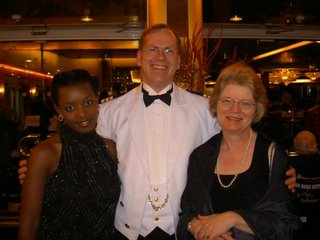
Scenic Cruising the Amazon River
The Amazon is a gigantic system of rivers and forests, covering almost half of Brazil and extending into neighboring countries. The wide stretch of river, known as Rio Amazonas, runs between the cities of Manaus and Belém, though the various rivers that join to form it provide a navigable route for ocean-going vessels to the other side of the South American continent. The forest still keeps many of its secrets; to this day, major tributaries of the Amazon are unexplored. Of the estimated 15,000 species of Amazon creatures, thousands of birds and fish and hundreds of mammals have not been classified. A cursory sampling of known animal species found in the forest - some common, some rare, some virtually extinct - includes jaguars, tapirs, peccaries, spider monkeys, sloths, armadillos, caimans, alligators, river dolphins, boa constrictors and anacondas. Forest birds include toucans, parrots, macaws, hummingbirds and gaviào (birds of prey), and insect life is well represented, with over 1800 species of butterflies and more than 200 species of mosquito. Fish such as piranha, tucunaré, piraracu, anuanã, piraíba and poraquê (electric eel) abound in such an amazing diversity of species that biologists are unable to identify much of the catch found in Belém’s markets. Don't expect to meet remote Indian tribes or dozens of free-ranging beasts though, because in both cases contact has been synonymous with destruction, and both have sensibly fled from accessible areas.
Devil’s Island
January 11, 2005
Today I woke up about 8 a.m. and went up to meet mom for breakfast and couple of other people she had met also. I didn’t eat much mostly fruit which is good. I am trying not to gain weight on this world voyage. Around 9 we went on the tenders to go to Devil’s Island because Devil’s Island does not have a place for ships to tie or a dock for the ship. When we reached the Island, it was very humid and hot. The Island is full of greenery, coconut trees, monkeys, parrots, and some other animals that I don’t know what they are called. The Island also has chickens, for the people who live there. The Island is very small and it used to be a place where the French sent prisoners there from 1850-1936. When the prisoners were sent there they weren’t able to escape because the French had many guards and also there were many sharks in the water incase they tried to escape by swimming or on boats. For some of you who don’t know much about how prisoners were treated on Devil’s Island in 1850-1936 read the book about Papillon or see the movie. I personally thought the island was beautiful it was so tropical. There were so many coconuts and the sea had amazing colors. I tried not to go in the water because of all those warning about sharks in the water. I don’t want to be shark meat. The ancient jails that were deteriorating were amazing to look at. I was so sad that I didn’t have my digital camera with me. I ended up taking Nate’s thinking I would save some money since he doesn’t use it. I even charged it and now it won’t work. I am so mad now I have to use dads; thank god that dad brought one with him. In all I am having a wonderful time here on the Prinsendam.
(P.S. As I am writing this dad is on his bed snoring away in a deep sleep).
Until next time always, Alemitu.
Jan 10, 2006
Well I have been aboard the Prinsendam for 5 days and nites and am just now starting to feel that this is our home for the next 4 months. The staff I work with are excellent and I am the newbie aboard in the dept which is fortunate as there has been a ton of things to do this week…i.e. Vaccinate all the crew and passengers who for one reason or another didn’t bring their yellow card or documentation. This is essential to pass the extremely difficult and often time capricious public health officials in Santarem, Brazil we meet in 2 days time. Surveillance for ARI (Acute Respiratory Illness) ILI (Influenza like illness), and GIS (Gastrointestinal illness/symptoms) is done daily on both crew and passengers and submitted electronically to public health officials in next port of call. We are updating all crew charts, TB status, YF status, GI illness during last 3-4 days, as well as insuring they all have their physical and exam current including meds and medical needs met during cruise…all 500 of them.
Then there are the guests (passengers) who for the most part are teetering on the edge of life and death (or) mobility and immobility (or) health and illness. Care is primarily geriatrics with travel and motion related problems so far. These folks are rather demanding and expect solutions to problems which are rarely curable but often can be palliated for a period of time. I am concerned about the time when someone becomes critically ill….Oh well I signed up for this gig of my own free will. Until we communicate again.
Carter
_____________________________________________________________________
January 10, 2006
Our room is situated right across from the Infirmary, so it is in the middle of the ship and rather low to ensure stability. It is the last row of port holes above water level. Yesterday, as we were leaving Barbados, we could see the water from the waves above the level of our windows – and it has yet to cease. Poor Alemitu is suffering as the ship rocks and rolls. I rather enjoy the soothing rocking, sort of like a cradle with an occasional jerk. Carter, however, does not share me impression. He and Alemitu find the aid of Scopalamine and/or Meclizine necessary for the functioning of life.
The cabin steward brought Alemitu a chocolate on her pillow last night. Her cruise is complete.
Yesterday we landed in Barbados and Alemitu had a hankering to go shopping. I wanted to see the island, so we started out quite early to walk into town. One of the nurses on board went with us, or I should say, led us. We walked thru a pleasant park, saw a slew of crabs sunning on a cement culvert, as the air was full of the aroma of molasses. Alemitu was pleasantly surprised that the majority of the people has brown faces. But they will stared at her because they knew she was from a different part of the world. (Clothes, bone structure, demeanor?) The sun began to peak out between the clouds and I felt my skin frying. I had lathered with tons of sunscreen, but I knew I was doomed. We shopped for several hours, disappointed by the high prices, and then headed back when I felt dizzy (my water was depleted). We found a grocery store and bought more water and even carbonated banana juice. That was enough to sustain me until we got back to the terminal. Of course, there were numerous shops outside the terminal and Alemitu perused each on with care. She found the prices more reasonable and did buy an outfit she will be able to wear for an informal evening dinner.
My Tai Chi class is a little discouraging because despite the slow speed of the movements I still get my hands and feet in the wrong positions. Maybe the missteps will add to the physical exertion I am putting forth.
Alemitu finds that the seasickness is a good appetite suppressant, but Carter seems unaffected. He still eats two entries many evenings.
I am finding the gym rats to be funny. One guy rode the bike uphill for 5 miles only to find that he had gained weight. (I think the scales are questionable.) We just got a new entertainment group on board yesterday, so these kids will be in the gym quite a bit, I am sure.
Winnie
WORLD CRUISE 2006
January 6, 2006
We are now living the first full day of cruising. It is so difficult to describe the mixed feelings we are living with. Some are wonderful and others are heart wrenching. I’ll start at the beginning.
Carter left 12 hours before Alemitu, our neighbors Irv and Vilma, and I left. He joined the ship on Jan. 5, early in the morning. He was going to get settled and then meet us at the airport at 9 in the evening. That went as planned. Alemitu and I met Irv and Vilma at the airport, each of us a little sleepy because we had stayed up late packing those last indispensable items (many of which we soon wished we had left at home..). The flight to Dallas/Ft. Worth was fun. The flight attendant got to know Vilma and Irv, announcing over the pa system that they were headed for a round the world cruise in celebration of their 62nd anniversary. The entire plane clapped for them and they were given a little bottle of champagne.
The second leg of the flight journey seemed fine until we started the descent. Irv apparently gave Vilma a kiss, said he loved her and went to the rest room. Alemitu said it seemed as if he had been in the rest room forever when we heard a scream. Irv had collapsed in the bathroom and when I got to him, he was no longer breathing. We performed CPR until we had pulled into the gate, but it was to no avail. The medics met us at the gate, were able to intubate him, start an IV, but his heart function and breathing had stopped.
I called Carter, hoping he would be in the baggage area to meet us, but he had been unable to secure his passport from the ship, so was not able to join us for about an hour. I went with Vilma to the hospital where Irv was pronounced and Carter picked up Alemitu and the luggage, deposited her on the ship and joined us at the hospital. The hospital handled the situation with understanding and compassion, but a situation like this is never easy.
The next 12 hours were very emotional, to say the least. We did not encounter anyone who was not helpful. The hotel Vilma was staying in bent over backwards to make her time of grief private and fulfilled the necessities of such a trying time. They sent up breakfast and arranged for her to have someone in the room most of the time between my departure to join the ship and the arrival of her “son” Mark who was flying in from Seattle. Understandably, the only thing she wanted to do was to go home. Even though the hotel was beautiful and caring, she wanted the familiar. Little things were distressing. The bed was too tall for her to get in without a step stool. She slept little that night, often getting up to wander around. At one point she was trying to get back in bed and slipped, falling on the floor. Miraculously she didn’t fracture anything. She had several bruises only. I then forced her to stay in bed until morning and until I could obtain a stool for her.
We spent most of the morning calling friends and arranging with several services what would happen next. I was impressed by the speed with which the emergency trip cancellation service, the cruise line and the travel agent worked. We left before Mark’s arrival, so we don’t know when they are planning to return to Seattle or how Vilma is doing. It was terrible to have to leave her.
I went off the join the ship, trying to check in via the crew entrance, but I wasn’t on the list. So I was sent to the passenger side. I was not on that list either. Carter was called, saying he would “come get me”. I was working on very little sleep, struggling to stay awake – glad I had a cross work puzzle book with me to keep me occupied until he arrived. Of course, we were in opposite sites of the terminal, but with the help of cell phones, we made the connection. Who knows why I was never listed on the roster, but eventually the head of security was called and they agreed that I was ok to get aboard. I guess all that strength training wasn’t that evident and I didn’t look like a threat to security.
What a surprise to find my suitcases totally unpacked, thanks to my daughter and husband. Our room is the doctor’s quarters, right in the middle of the ship, across from the infirmary. We are still adjusting to its oddities. The bathroom is on the step-saver side. Or rather, no steps necessary side. One step to the side of the toilet and you are in the shower. There is no room to dress in there unless you are sitting on the toilet. It’s tight! Also, Alemitu is sleeping on a two cushion couch, scrunched up. We haven’t figured out how to open it up, if it does open up. And Carter and I are going thru readjustments as we share a double bed. Carter takes up the same amount of room in the bed, no matter what size it might be. So I guess I am the one making the adjustments…. We also don’t have an electrical outlet by the bed, so his sleep apnea machine is nonfunctional. Alemitu was not amused with his breathing noises during the night. Both she and I required a nap today. Carter is chipper. Nothing interrupted his sleep.
So we are off. The internet connections are spotty and both Carter and I are frustrated at times. He has multiple social requirements, so we have hardly had a chance to troubleshoot. Maybe tomorrow will be less demanding. We have met some very interesting people already. Many have cruised the world cruise before and seem to make this a tradition. The gym was full at 6:30 this morning, one lady asking Carter if he thought she could have dessert tonight if she just did a few more minutes on the elliptical machine.
January 7, 2006
How could I so carefully pack my razor blades and then leave the razor at home?
The sleep apnea machine got properly wired. Bless the technician.
Alemitu got a real bed after another sleepless night. She is happy beyond belief. Now if she could only get that piece of chocolate on her pillow each night…….
January 8, 2006
I think things are beginning to form a pattern. Carter is working a ton because he is trying to figure out exactly where everything is and what he is supposed to do. The nurses are being very patient with him, thank goodness.
One big frustration has been the lack of internet access. They are trying to connect our room with the internet, but don’t have the cable necessary. Maybe in Barbados. We did get on line today and were able to retrieve my work, family messages and a message from Vilma and Irv’s friend that Vilma has returned to Seattle. That was a relief to hear.
The cruise has so many activities, there is something for everyone. Alemitu went to a cooking class, only to return saying she never realized what went into crab cakes. No wonder she gained weight on a cruise! I have been attending historical lectures daily, and yes, I am going to the gym everyday. Kit gave me a workout routine and I take the notebook upstairs with me each time. I can’t seem to remember those exercises, maybe because I wish they would just disappear…..but I am doing them!
Today Carter, Alemitu and I got to have lunch together. Carter was trying to read the newspaper when I heard a thud in the background, followed by a low shriek. A passenger was down and wasn’t moving. I had to shake Carter to get his attention, but he ran to the every enlarging circle of on-lookers. They were able to get her in a wheel chair and down in the infirmary very quickly. Far better response than on the plane….
We passed by Dominical Republic, as well as Cuba, so I thought of Brooke and Jim. Beautiful scenery. Almost like cruising in Alaska with the islands and their mountains hidden in a light fog. I haven’t felt isolated on the water, yet.
Our dinner table is interesting, of course. We have a mother from Manhattan, accompanied by her son who is an artist. He brings his calorie counting book to the table and announces what we are consuming. We found them stiff for the first part of the first evening, but Carter got them loosened up and we are all laughing and having a great time. Yesterday we were joined by another couple, also with a similar age disparity, but this time the husband is older. He was filling Carter in on working with the Mafia tonight. We have yet to hear the whole story.
Alemitu brought along her beading and has received so much attention from passengers who are bringing her jewelry to fix or to have her advise them on what to do. Of course, she is the most stunning person each evening as she dresses for dinner. She and I are having many rendezvous at the Java café for a cup of tea or coffee. The crew love her because she is closer to their own age.
Photos of Grand World Cruise at www.flickr.com/photos/carterhill
For intinerary review of the 2006 Prinsendam Grand World Voyage check the following website at www.hollandamerica.com/cruise-destinations/grandworldvoyage.
Good luck!
Carter and Winnie
CHRISTMAS 2005
Thirty-third Annual Christmas “Missal”
Carter 57 is stable at 197# with cholesterol stable and prostatic specific antigen rising (on drugs for both). He still works 18 night shifts/ month in the ED and exercises 3-4 times per wk. Excursions this year included Miami, Vietnam, Washington DC, Denver, Ashland, and the Caribbean for the usual reasons….sanity and escape! This year has been focused on health care remediation (lipoma removals, arthroscopic knee surgery, a sleep study for mild sleep apnea, colonoscopy for 50 some-things, and prostate biopsy to chastise him for his family history)….all is well in the final analysis.
Winnie is expanding her work and time commitment with Prevention MD where she provides Travel-Medicine advice to upcoming world travelers via an Internet consultation.
With only Alemitu and Kit home this year, she has had more time to devote to church activities (hospitality and Stephen Ministries), books on tape, and keeping up with Carter’s ever increasing money-laundering activities. Winnie has reluctantly taken up a physical fitness regime with her very own personal trainer (Kit) and the results are conflicting (depends on who you speak to).
Ben (Mako) is 25 and truly independent…from his parents! He is a grad student and living (with Mika) in Cambridge, Massachusetts attending MIT’s media lab. He and other folks are creating a $100 laptop for the Third World (One laptop per child OLPC). His responsibilities are primarily in creating/applying a Linux-based software operating system for this computer utilizing his talents/experience in literature and technology. Needless to say, we haven’t heard much from him this fall but consult his website at
http://mako.cc/copyrighteous for cyber-updates pertinent to his world.
Mika is 25 and finished her Master’s degree in Nutrition from Columbia. She currently loves her laboratory research job at Harvard in the field of nutrition/polio. She has several websites which outline some of her interests;
http://www.nutritionchick.com and
http://www.flickr.com/photos/soulfish. Winnie and I miss her tremendously….She is the only person in the family who writes to us regularly!
Kit 23 is our second college grad and has used this year to transition to the ‘working world’. He is a certified personal trainer initially with Gold’s Gym (read corporate pond scum) here in Seattle. He recently became an Independent PT with all the attendant joys and frustrations but seems much happier. Consensus of everyone who works with him… “He is very good at this and really fit.” All this is to provide a nest egg and livelihood while pursuing his long term passion in music and theatre in the NYC scene next summer.
Nate is 21 and in his second year at Linfield College in Oregon after scribing with Dad this summer in the ED. He is really enjoying his college educational opportunities and is midway through a class learning sign language for the hearing impaired. He loves the symbolic/theatrical aspects of this language. He is leaning toward a new major in International Communications (includes history, sociology, anthropology, international studies, and religion) with a minor in Theatre. Sounds to me like 5 years or a lot of summer school classes.
Lisa is 20 and still flogging away in Denver (Junior at Johnson and Wales University). Still trying to find her niche in the food and beverage/ hospitality field, she is searching for that great job that doesn’t involve a great deal of time interacting with other people…She does her best work and seems happiest when working independently. Methinks some time in the trenches and away from school will give her the direction and enthusiasm she seems to be missing right now. She entertained dad on campus this fall during parent’s weekend…and dad really enjoyed the cultural offerings and meeting her many friends at the dining commons… Lisa truly appreciated the BBQ dinner out!
Alemitu is 19 and has completed her H.S. curriculum….Hooray! She is considering vocational training in 2006 in an allied health field (yet to be determined). Still working in child care after school, she has been a disciplined saver in addition to her considerable contribution to the nation’s GNP. She works out regularly with dad but these 2 hours of sweat don’t compare to the physical exhaustion we observed after her H.S. graduation photo shoot. She is very, very excited about her inclusion in Dad’s upcoming World Cruise but is more a little nervous about the sleeping arrangements in an officer’s cabin (Mom and Dad) aboard the Prinsendam…See website for her (and our) contributions:
http://www.mannhill.blogspot.com.
Woguyo is 17 and is trying to position herself for H.S. graduation from boarding school in MO during 2006-2007 academic years. She still finds math an incomprehensible language but appears to be moving forward nicely on most other fronts. After a “Come-To-Jesus” visit from Mom and Alemitu in October, she now realizes 1) She is not welcome home without a diploma 2) She can not survive on minimum wage in MO and living on her own as a H.S. dropout. 3) There are real-life consequences to poor decisions.4) We do love her and would love to help her fulfill her life’s dreams…on OUR terms!
We as a family in 2005 find we are preparing ourselves and our children for the reality of life without their parents…at least on a day to day basis. We are very proud of their successes and mutually suffer with their set backs… helping them to learn and grow in experience as their lives progress. We are returning to an earlier life style where outside friendships can be nurtured again (in person), and we can think about our personal needs at least on a par with those of our dependents. We look forward to your communications and letters. Please visit our website
http://www.mannhill.blogspot.com regularly during next 4 months for our thoughts, photos, musings as we travel around the world where Carter is the ship physician, and Winnie and Alemitu explore the many remote and exotic destinations in the Southern Hemisphere:
www.hollandamerica.com; Destinations; Grand World Voyage; 2006 brochure(bottom of webpage), Prinsendam sailing Jan 5-April23, 2006 for those interested in following along. Photos will be posted regularly at http://www.flickr.com/photos/carterhill.
Carter & Winnie Hill
6805 SE 32nd St
MercerIsland,WA 98040 carterhill@comcast.net
December 26, 2005

